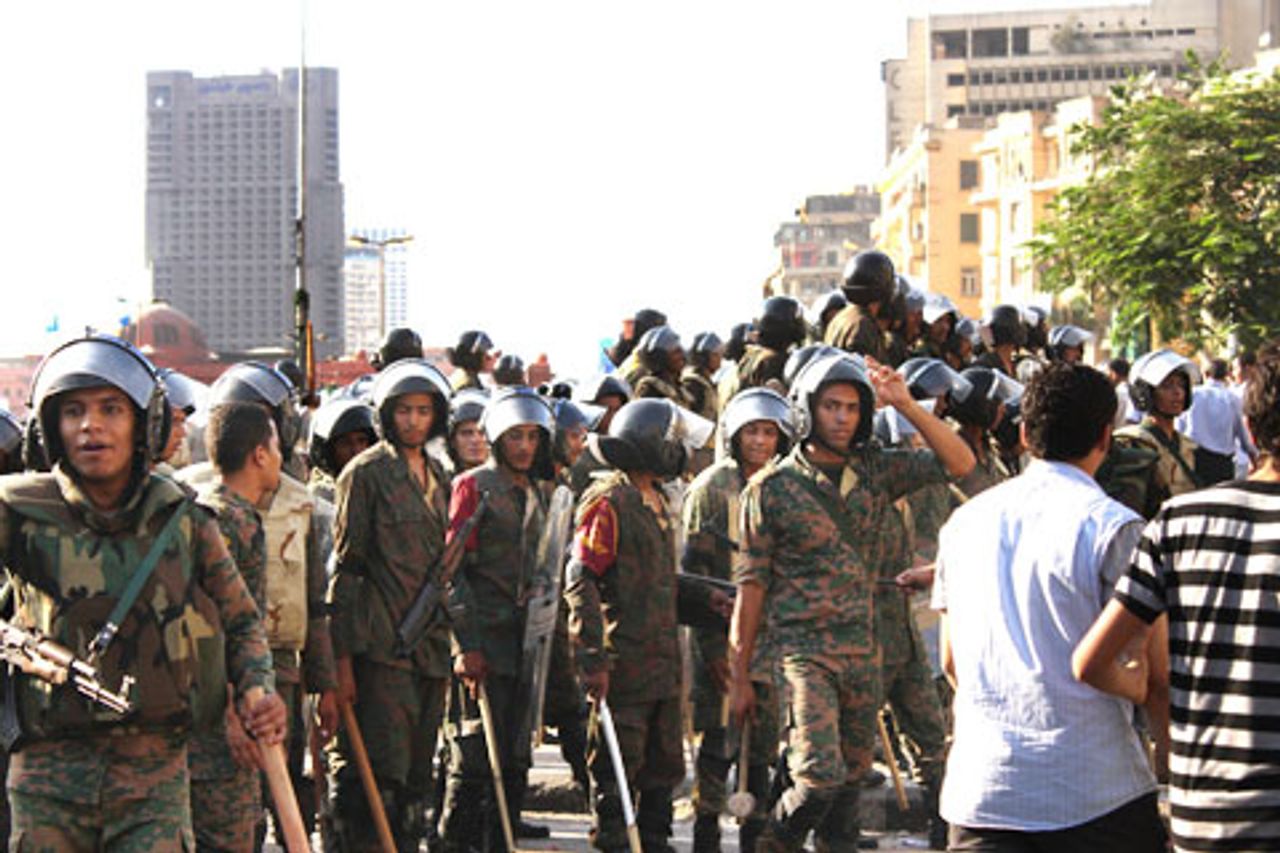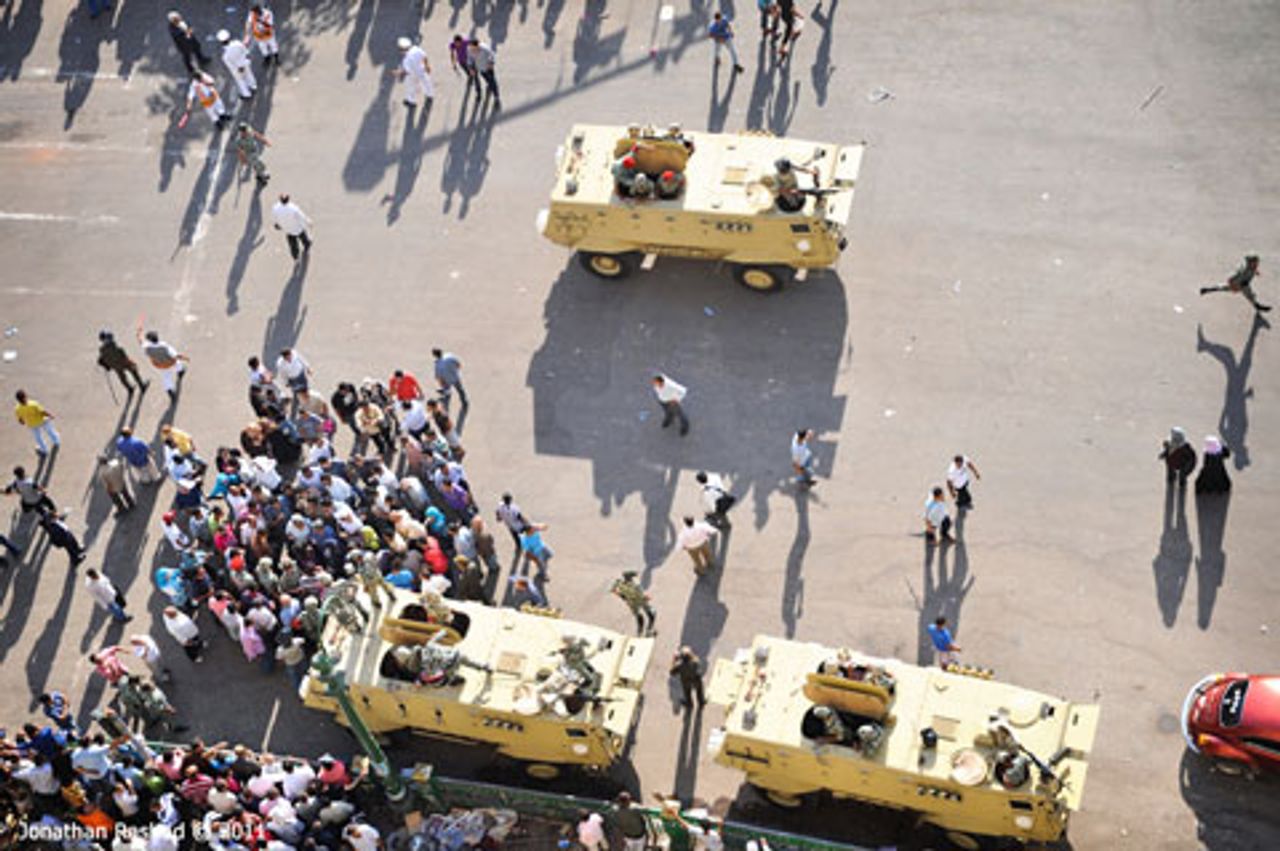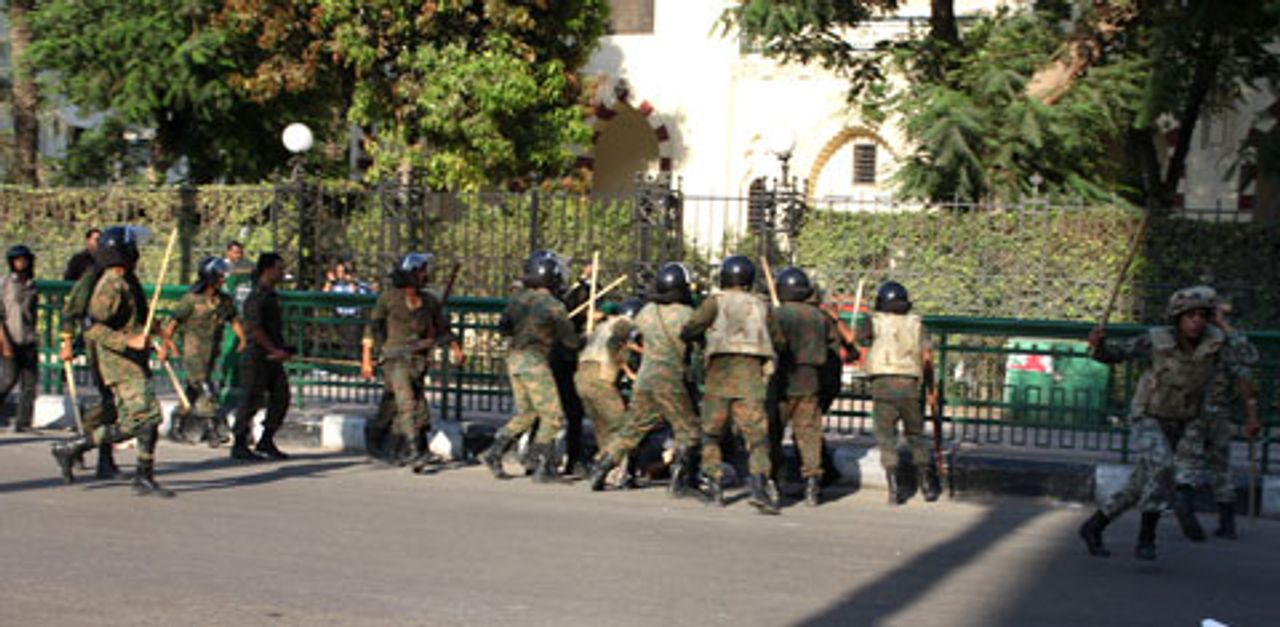On August 1 the Egyptian military and the notorious Amn al-Markazi (Central Security Forces) brutally attacked peaceful protesters on Tahrir Square in Cairo, clearing the Square and bringing the protests to a halt. At around 2 p.m., armored trucks moved to the entrances of the square and the military began to fire warning shots into the air.
 Egyptian troops moving against Tahrir Square protesters on August 1 [Photo: Nora Shalaby]
Egyptian troops moving against Tahrir Square protesters on August 1 [Photo: Nora Shalaby]Tahrir Square had been largely deserted by protest groups and official “opposition” parties, who abandoned the sit-in on Friday. Those who remained on the square were largely families and supporters of martyrs—that is, protesters killed during the revolutionary struggles that led to the ousting of US-backed President Hosni Mubarak, on February 11.
Eyewitnesses reported that young protesters responded by throwing stones at the soldiers and plain clothes police officers entering Tahrir with automatic machine guns. During the raid the military and the security forces brought down the tents and chased hundreds of protesters out of the square. Several protesters were injured, and the junta arrested at least 25 of them.
When the military stormed the square, some of the protesters fled to hide in Omar Makram Mosque close to Tahrir Square; the army also began to attack the mosque. It was reported that some shop owners in downtown Cairo were mobilized against the sit-in by police and joined the attack.
A protester named Galal described the scene: “They entered and they destroyed the tents while we were inside. We had old women and mothers of martyrs with us and they had to run away.” Galal is a member of one of the martyr’s families who began the sit-in over four weeks ago after the police brutally attacked protesters in Downtown Cairo injuring more than 1,000. His brother Nasser was killed outside the police station in the working class district of Imbaba, during the first days of the mass uprising against the Egyptian regime in January.
 Tanks clear Tahrir Square [Photo: Jonathan Rashad]
Tanks clear Tahrir Square [Photo: Jonathan Rashad]The renewed attack by the military on Tahrir Square, one of the icons of the Egyptian Revolution, is the culmination of an organized counterrevolution after the Egyptian workers and youth brought down the longtime dictator Hosni Mubarak in February. In recent weeks, the US-backed military junta worked together with all the official “opposition” parties and groups in Egypt to stop a massive wave of protests and strikes which spread all over Egypt.
On July 8 millions of workers and youth protested in all Egypt’s major cities and demanded a “second revolution”. A massive strike movement and sit-ins all over Egypt followed.
The Egyptian masses clearly identify the junta as an extension of the old regime, which stands for exactly the same policies as the Mubarak dictatorship. Since Mubarak’s generals took power, social spending has been cut, military rule remains, and Egypt is still a firm ally of the US and Israel.
The call for a “second revolution” by Egyptian workers and youth increasingly worries US imperialism and the Egyptian bourgeoisie. They fear nothing more than an independent movement of the working class which would threaten capitalist rule in the entire Middle East.
US imperialism and other reactionary regimes are increasingly lending support to the Islamist groups. Only recently the US announced it would establish an “open dialogue” with the Muslim Brotherhood. The Salafist groups in Egypt are widely sponsored by Saudi Arabia, which opposed the removal of Mubarak.
In order to control the situation, the official “opposition” parties—liberal, Islamist or pseudo-left—formed an alliance to save the junta. On July 27 over 35 political parties and groups formed a “United Popular Front”, and agreed to halt any political discussion and leave all “controversial issues” aside.
 Military beating up a protester [Photo: Nora Shalaby]
Military beating up a protester [Photo: Nora Shalaby]This set the stage for an Islamist provocation on July 29. Islamist supporters were brought into Cairo from rural areas in Egypt in an operation carefully prepared by Islamist groups like the Muslim Brotherhood, the Salafis and al-Gamaa al-Islamiya—who back the military regime and its anti-strike law, as well as violent measures against protesters and strikers. The pseudo-left forces used these events as a pretext to abandon the protesters remaining on Tahrir Square.
The most cynical role in paving the way for the counter-revolution is played by the pseudo-left parties of the Socialist Front—the Revolutionary Socialists (RS), the Democratic Workers Party and the Socialist Alliance Party. They are open opponents of calls for a “second revolution,” instead presenting the junta as a progressive force that will grant democratic and social reforms.
The pseudo-left groups struck a deal with the Islamists and joined the “United Popular Front”. Soon after the Islamists began their march on July 29, thirty-three political parties and groups including the pseudo-left forces used this as a pretext to withdraw from the protests and end the sit-in.
This reactionary maneuver by the Egyptian bourgeoisie supported by the pseudo-left not only paved the way for the violence recently unleashed by the military junta against the population, but sets the stage for violent offensive of the junta against the class struggles in Egypt.
